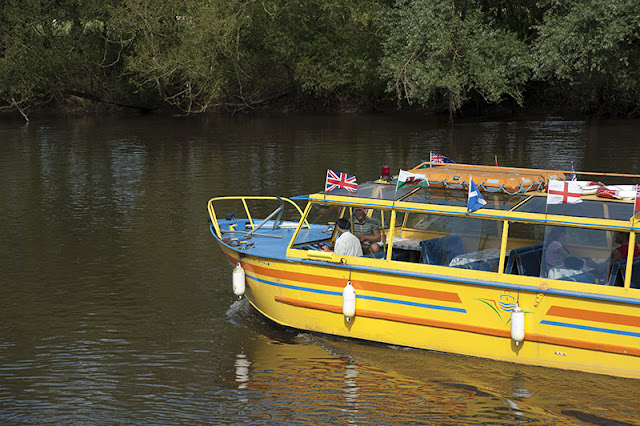For this set of images I've gone to Symonds Yat West and to the the River Wye where boat trips are organised and decided to make this the subject of my image sequence.
In this set of images I've focused less on thoughts of composition and lighting etc and instead captured what instinctively felt right.
I felt this image as the starting image gave a good indication of what the image set was about.
The happy Captain of the boat undertaking the river trips welcoming potential customers. This image again is a good starting point for the set of images and is one step forwards as he stands next to the board shown in the first image.This was actually taken toward the end of the set but felt better having it in the beginning when I considered the flow of images
Empty berthing slot and the walkway to the boat when it arrives. Using visual language it indicates the boat is not ready and there will be a wait. It could cause viewers with logical minds to question why the Captain is in the earlier image but I am still happy with this flow
Waiting.....for the boat to arrive and allow boarding

The boat's not here yet but perhaps its arriving....the children excitedly point toward the boat
It appears that someone forgot to secure the boat....
...however local staff quickly recover the situation.
This image shows people walking across the gangway over the water and on to the boat
In this image it focuses on the people actually on the boat and getting ready to find a seat
People in this image are now seated
Though its clear that adults and children all find that the best seats are at the back of the vehicle they are travelling in, on a sunny day this choice of seat in the open air appears an even better choice
I continue to let the sequence of events unfold and the next logical step with people on board is for the boat to start its journey. Showing just the front gives the impression the boat is moving from right to left and I continue this theme in the flow of images
In this image the boat trip has more obviously begun
This image further impresses on the viewer that the boat has left its starting position and that the are other users on the water. Driving on the left it appears is a rule for boats as well as cars
While waiting for the boat to return I show in these intermediate images other water users
Faster going with the water current emphasised by the positioning of the subject within the frame
This image in contrast to the canoeist where motor power is seen to be able to generate faster movement than what can be created by hand
In this next image showing the boat further away implies it is travelling fast
These lads highlight the fact the man power can be tiring and are having a rest. The smile on one face shows its an enjoyable hobby.
To conclude this set of images I now take some images of the boat returning back to its mooring position
This image continues the progression of the boat to docking at its birth and preparing for the passengers to disembark
I've taken this image to show the boat has docked and the Captain and his assistant assist the passengers to leave the boat ....
...and cross the gangway to return back to shore
Exercise Learning's
a) This was enjoyable and I can see how how a story can be told in a set of images. I'm sure with a careful selection of images that the story can be told without using words, much like reportage photography
b) I think I would have like to get closer to the people so that the viewer is better engaged with the subjects on the set of images. Surprisingly I felt uncomfortable about taking images of people like this though no-one objected. Perhaps in future I could also ask if they mind me taking images of them, explaining why of course, as this may allow me to get the subjects more engaged in the image and importantly the viewer can get a better connection. A good learning for this exercise
c) I can see how easy it is to focus on the taking of the images but not give full attention to all the mechanics of what makes a good photograph. This is something for more to give further attention and concentration to going forwards when doing reportage photography
d) There can be a lot going when when taking a set of images and it can be easy to get distracted and forget the focus of the set.
e) A decision may sometimes need to be made of whether to include a star, middle and end section to a set of images. In this case I wanted to tell a story so on this basis it seemed sensible to include these 3 aspects. I can see that in some reportage photography that this may not be achievable or desirable. However a conscious thought of what is wanted is good to have at the start























No comments:
Post a Comment